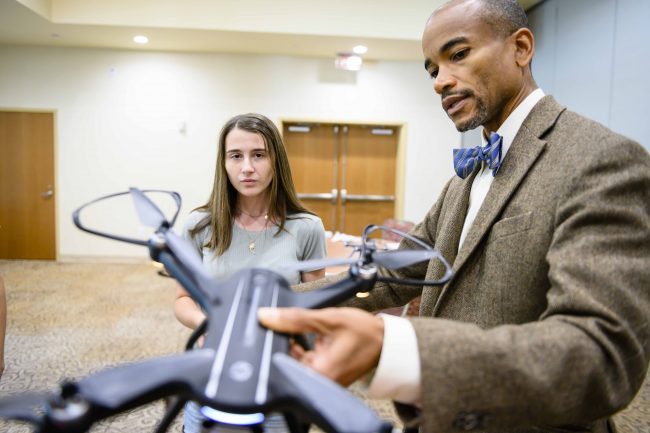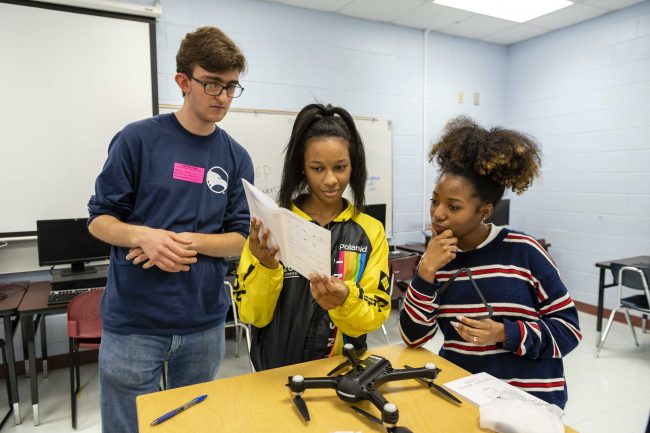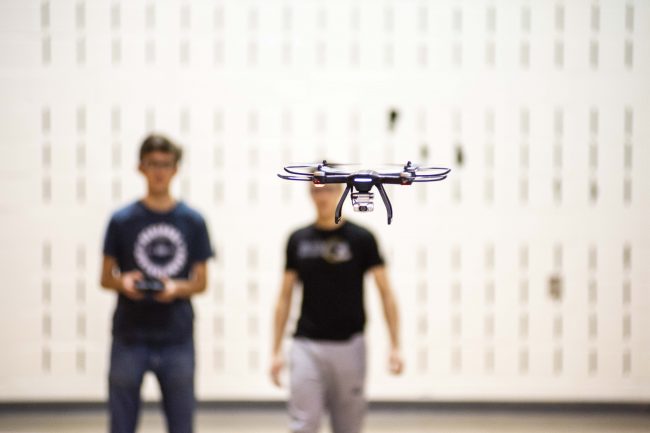High school drone racing teams looking to set the pace in Georgia Southern engineering design challenge

Eight Savannah-area high school engineering teams hope to race ahead of the competition in the Engineering Design Challenge (EDC) 2020: Eagle —Remotely Operated Aerial Reconnaissance (ROAR) at the Georgia Southern University Armstrong Campus on April 25. In this year’s competition, teams will learn how to fly drones, and they will design a 3D-printable grappling system to pick up a mock reconnaissance payload and design a static positioning system for a wire hanger-based payload, also to be picked up by their grappling system.
The grappling system can be any type of device design that can be used to pick up the mock reconnaissance payload and the wire hanger payload. The reconnaissance payload is a 3D printed tripod with a loop at the top. The teams will also need to design a static positioning system to hold up the wire hanger in a stationary position so it can also be picked up by their grappling system.
At the competition, teams will race head-to-head in a randomly seeded, double elimination tournament where they will deliver as many payloads across the drone airfield as possible in three minutes. The teams will fly through a 30-inch hoop and deposit the payloads in the designated landing locations. They will also create a video presentation of their project highlighting their design process, final design and the basic physics of drone flight.
“In the process of designing a grappling system and the wire hanger payload, the students will experience all four steps used in engineering practice,” said Wayne Johnson, Ph.D., Eagle-Roar director and mechanical engineering professor on the Armstrong Campus. “They will get exposure to computer-aided design software and 3D printing, which are ubiquitous in engineering design practice.”
Johnson and three mechanical engineering students started working on the project last fall. Their team has now grown to nine students, who will coach the high school teams throughout the challenge. Each team will also be paired with a professional engineer, who will serve as a project mentor. Johnson said the 2020 challenge was inspired by the popularity of drones and NASA’s Mars 2020 Perseverance rover mission, which will launch in July and include an autonomous helicopter.

“The use of drones presents a relatively complex engineered system that can be used as a means to introduce and apply physics, math and engineering concepts to high school students in a tactile and accessible manner,” Johnson said. “Based on this introduction, students can possibly purchase their own drone and continue to create, explore and build upon when we have taught them. We hope to continue the use of drones in subsequent challenges.”
Lydia Poole, a sophomore mechanical engineering major, completed the requirements for the competition in order to better help the high school teams prepare. She said the high school teams will be introduced to more than just engineering concepts and techniques.
“Because they are required to carry payloads with their drones, students must become more familiar with aerodynamics and the physics behind how a drone operates,” Poole said. “On top of everything, students are also learning how to work as a team and communicate ideas collectively.”

Johnson said the challenge will offer a unique opportunity for the student coaches, in addition to the high schoolers.
“Our student coaches get an opportunity to enhance their leadership and other soft skills as they provide weekly guidance and assistance to the high school teams,” he said. “These types of skills are invaluable to employers. Also, the EDC provides the project mentors and their organizations with an opportunity to engage and connect with the local community in a discipline-relevant activity.”
Johnson hopes the EDC exhibits the opportunities the Georgia Southern College of Engineering and Computing has to offer to prospective students.
“The Armstrong Campus in Savannah is expanding our course offerings in mechanical engineering, so students can continue to live and work in Savannah while pursuing the first three years of their degree,” Johnson said. “Regardless of the campus, the College of Engineering and Computing offers outstanding and dedicated faculty who will prepare students for whatever engineering challenges they may encounter once they leave our Eagle’s nest.”
The competition is April 25 at the Armstrong Center at 1 p.m. For more information on the EDC and the Georgia Southern College of Engineering and Computing, visit engineering.armstrong.edu/edc/.
Posted in Press Releases

